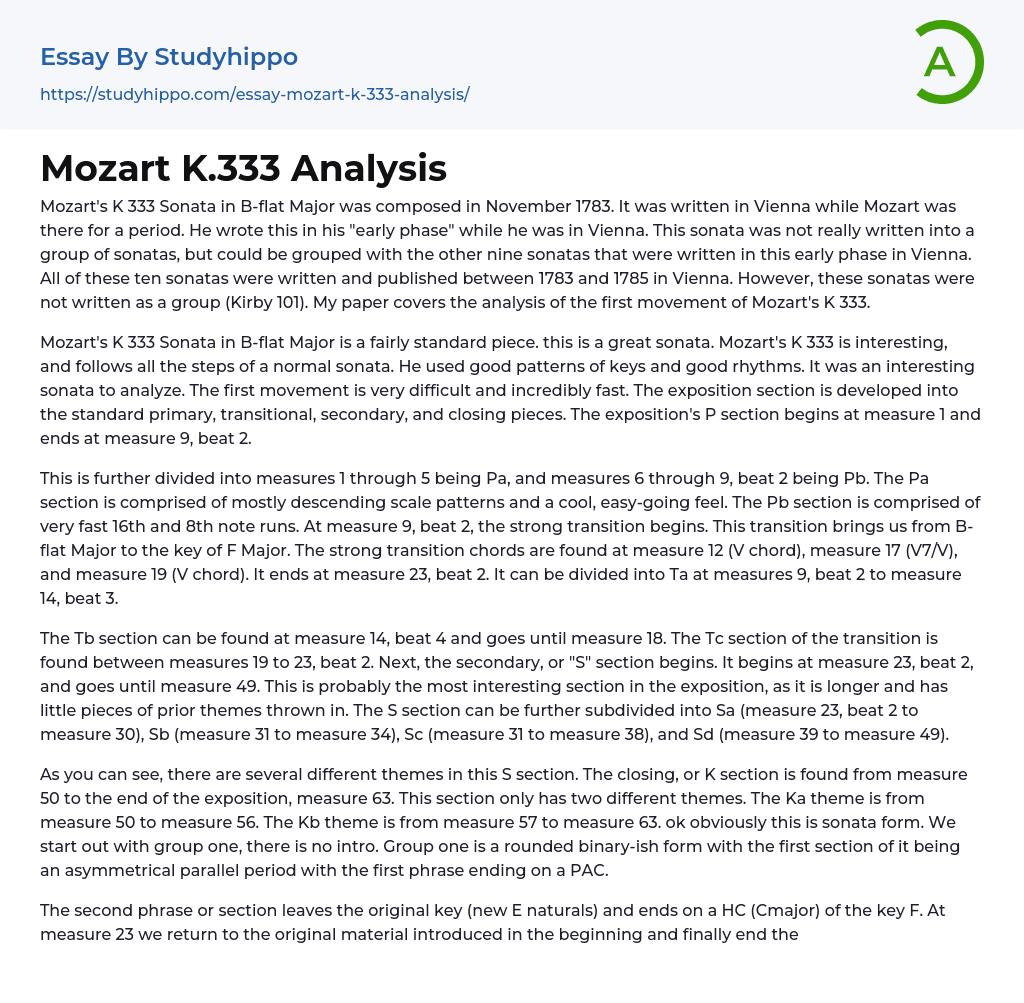Mozart's K 333 Sonata in B-flat Major was composed in November 1783. It was written in Vienna while Mozart was there for a period. He wrote this in his "early phase" while he was in Vienna. This sonata was not really written into a group of sonatas, but could be grouped with the other nine sonatas that were written in this early phase in Vienna. All of these ten sonatas were written and published between 1783 and 1785 in Vienna. However, these sonatas were not written as a group (Kirby 101). My paper covers the analysis of the first movement of Mozart's K 333.
Mozart's K 333 Sonata in B-flat Major is a fairly standard piece. this is a great sonata. Mozart's K 333 is interesting, and follows all the steps of a normal sonata. He used good patterns of keys and good
...rhythms. It was an interesting sonata to analyze. The first movement is very difficult and incredibly fast. The exposition section is developed into the standard primary, transitional, secondary, and closing pieces. The exposition's P section begins at measure 1 and ends at measure 9, beat 2.
This is further divided into measures 1 through 5 being Pa, and measures 6 through 9, beat 2 being Pb. The Pa section is comprised of mostly descending scale patterns and a cool, easy-going feel. The Pb section is comprised of very fast 16th and 8th note runs. At measure 9, beat 2, the strong transition begins. This transition brings us from B-flat Major to the key of F Major. The strong transition chords are found at measure 12 (V chord), measure 17 (V7/V), and measure 19 (
chord). It ends at measure 23, beat 2. It can be divided into Ta at measures 9, beat 2 to measure 14, beat 3.
The Tb section can be found at measure 14, beat 4 and goes until measure 18. The Tc section of the transition is found between measures 19 to 23, beat 2. Next, the secondary, or "S" section begins. It begins at measure 23, beat 2, and goes until measure 49. This is probably the most interesting section in the exposition, as it is longer and has little pieces of prior themes thrown in. The S section can be further subdivided into Sa (measure 23, beat 2 to measure 30), Sb (measure 31 to measure 34), Sc (measure 31 to measure 38), and Sd (measure 39 to measure 49).
As you can see, there are several different themes in this S section. The closing, or K section is found from measure 50 to the end of the exposition, measure 63. This section only has two different themes. The Ka theme is from measure 50 to measure 56. The Kb theme is from measure 57 to measure 63. ok obviously this is sonata form. We start out with group one, there is no intro. Group one is a rounded binary-ish form with the first section of it being an asymmetrical parallel period with the first phrase ending on a PAC.
The second phrase or section leaves the original key (new E naturals) and ends on a HC (Cmajor) of the key F. At measure 23 we return to the original material introduced in the beginning and finally end the exposition at 38 in the Dominant. 38
also transitions the piece into group two of the exposition. This could be totally wrong, but I only hear group two lasting until 50, after that it seems like a huge cadential extension up to 63. all this gets repeated and then we move on to developoment.
- Band essays
- Baroque Music essays
- Blues essays
- Classical Concert essays
- Classical Music essays
- Concert essays
- Hip Hop essays
- Jazz essays
- Ludwig Van Beethoven essays
- Michael Jackson essays
- Mp3 essays
- Music Concert Report essays
- Music Reference essays
- Music video essays
- Musical Instruments essays
- Opera essays
- Piano essays
- Popular music essays
- Recording essays
- Rock And Roll essays
- Rock Music essays
- Singing essays
- Sonata essays
- Song essays
- Sonnet essays
- Tupac shakur essays
- John Locke essays
- 9/11 essays
- A Good Teacher essays
- A Healthy Diet essays
- A Modest Proposal essays
- A&P essays
- Academic Achievement essays
- Achievement essays
- Achieving goals essays
- Admission essays
- Advantages And Disadvantages Of Internet essays
- Alcoholic drinks essays
- Ammonia essays
- Analytical essays
- Ancient Olympic Games essays
- APA essays
- Arabian Peninsula essays
- Argument essays
- Argumentative essays
- Art essays
- Atlantic Ocean essays
- Auto-ethnography essays
- Autobiography essays
- Ballad essays




